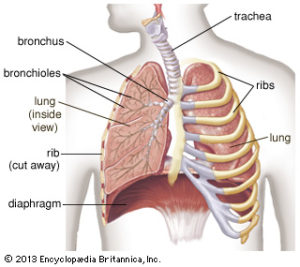Diaphragmatic Breathing
We use many muscles to help us breathe, including our respiratory diaphragm (which we will refer to simply as the diaphragm in the remainder of this post), intercostal muscles between our ribs, and some other muscles around the area of our neck and shoulders. Your physical therapist may have recommended you practice a specific exercise called diaphragmatic breathing.
The benefits of diaphragmatic breathing include generalized relaxation (it reduces the activity of the body’s sympathetic nervous system, also known as the “fight or flight” system), reduction of tension around the pelvic floor, and reduction of tension around the neck and shoulder areas.
 The diaphragm is a large dome of muscle at the base of your ribcage. Here is a picture of the diaphragm (courtesy of Encyclopedia Brittanica):
The diaphragm is a large dome of muscle at the base of your ribcage. Here is a picture of the diaphragm (courtesy of Encyclopedia Brittanica):
During normal breathing, every time you take a breath in (inhale), your diaphragm contracts, which causes the dome of your diaphragm to move down towards your feet as your belly relaxes and moves outwards. When you breathe out (exhale), the dome of your diaphragm moves back up to its starting position, and your belly comes back into its starting position. Typically, with normal breathing, the amount of motion that occurs around your belly as your diaphragm is moving is about equal to the amount of motion that occurs around your chest.
To practice diaphragmatic breathing, we work on shifting the motion of breathing to allow for more motion around your belly (meaning more motion of the diaphragm), and less around your chest. Below, we’ve included a short video with instructions about how to perform diaphragmatic breathing as an exercise, so you can start to experience the benefits of diaphragmatic breathing at home.
Our Articles
-
27 December, 2019 No comment
Our Wellness Center wishes you a happy holiday!
-
16 February, 2018 No comment
Finding Safety after Trauma
-
16 December, 2017 No comment
Diaphragmatic Breathing
-
29 October, 2017 No comment
Improve your Driving Posture & Reduce Pain And Stress
-
29 October, 2017 No comment
Cervical (Neck) Range of Motion (ROM)
-
29 October, 2017 No comment
The Proper Way to Stretch Your Calf Muscles
-
29 October, 2017 No comment
4 Easy Steps to a Serratus Anterior Exercise
-
24 October, 2017 No comment
Hamstring Stretch
-
31 January, 2017 No comment
Light Therapy, Phototherapy, and LASER Therapy


Sorry, the comment form is closed at this time.